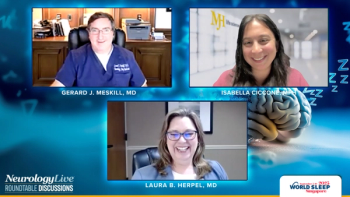
Narcolepsy Type 1 and Type 2
Michael J. Thorpy, MD: We talked a little about the different types of narcolepsy—type 1 and type 2. Type 1 is associated with cataplexy, which needs to be present for type 1 narcolepsy. You need to have those sleep studies, as Russ mentioned—the multiple sleep latency test—to document sleep onset REM [rapid eye movement] periods during the day, and also looking for sleep onset REM periods at night. That’s a new feature in the diagnostic criteria—having a sleep onset period at night counts toward having type 2. If a patient has 2 sleep onset REM periods—1 during the day and 1 at night—that’s consistent with the diagnosis of narcolepsy. But also measurement of CSF [cerebrospinal fluid] hypocretin.
How easy is it to get CSF hypocretin measured?
Russell Rosenberg, PhD, DABSM: Well, not many patients want to undergo a lumbar puncture to get that cerebrospinal fluid, and there are limited places in the United States that do this. My experience is that very few sleep specialists will actually do that. Maybe Dr Maski can talk about this, too, because in those cases where we’re just not sure—and it’s really important to nail down that diagnosis—I’ve known patients to agree to undergo that test.
Michael J. Thorpy, MD: And is it more important to be able to do it in children than in adults? Or not necessarily?
Kiran Maski, MD, MPH: I think that in cases where you’re not able to access a sleep study or a pediatric sleep center to do the testing appropriately, it is another way of making the diagnosis. Depression is a common comorbidity of narcolepsy, and oftentimes patients are on medications like SSRIs [selective serotonin reuptake inhibitors] or SNRIs [serotonin-norepinephrine reuptake inhibitors] that actually suppress REM sleep. So when somebody goes to do the polysomnogram and the multiple sleep latency test, it’s a false-negative test because it suppresses REM. So in those cases where narcolepsy is highly suspected—and I would say also, I test for this HLA [human leukocyte antigen] allele—it increases the likelihood that the hypocretin would be low if the HLA is, in fact, positive. So in those situations, I’ll favor doing a lumbar puncture for low hypocretin values.
Michael J. Thorpy, MD: A value, of course, in type 1 narcolepsy because type 2 narcolepsy patients have normal hypocretin. They have the same sleep study findings as the type 1 patients—with the sleep onset REM periods and the sleepiness—but, of course, they don’t have cataplexy. If you were to do CSF hypocretin, you’d find that it was normal in those patients.
Russell Rosenberg, PhD, DABSM: Dr Thorpy, I just wanted to follow up on 1 thing from Dr Avidan, and this isn’t part of the diagnostic criteria. Often, patients with narcolepsy have epic dreaming. I think this is somewhat overlooked, even by some sleep specialists. They don’t ask about the quality and the content of dreams. These patients have some of the most action-packed dreams I’ve ever heard. I think that speaks to this whole idea that Dr Maski was talking about. This is a REM-based disorder, so there’s REM breakthrough during the daytime but at nighttime, they are really going to town with regard to their dreams.
Michael J. Thorpy, MD: Yes. This can be particularly helpful information if you have somebody who doesn’t quite meet the diagnostic criteria for narcolepsy and may not have those 2 sleep onset REM periods but are very sleepy. Finding out about this abnormal dream phenomena at night—the paralysis, the bizarre dreams, the nightmares, the hallucinations—all that can add up to illustrating a picture that would make you think about narcolepsy.
Newsletter
Keep your finger on the pulse of neurology—subscribe to NeurologyLive for expert interviews, new data, and breakthrough treatment updates.




































